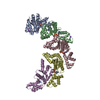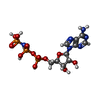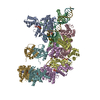+Search query
-Structure paper
| Title | The bacterial replication origin BUS promotes nucleobase capture. |
|---|---|
| Journal, issue, pages | Nat Commun, Vol. 14, Issue 1, Page 8339, Year 2023 |
| Publish date | Dec 14, 2023 |
 Authors Authors | Simone Pelliciari / Salomé Bodet-Lefèvre / Stepan Fenyk / Daniel Stevens / Charles Winterhalter / Frederic D Schramm / Sara Pintar / Daniel R Burnham / George Merces / Tomas T Richardson / Yumiko Tashiro / Julia Hubbard / Hasan Yardimci / Aravindan Ilangovan / Heath Murray /  |
| PubMed Abstract | Genome duplication is essential for the proliferation of cellular life and this process is generally initiated by dedicated replication proteins at chromosome origins. In bacteria, DNA replication is ...Genome duplication is essential for the proliferation of cellular life and this process is generally initiated by dedicated replication proteins at chromosome origins. In bacteria, DNA replication is initiated by the ubiquitous DnaA protein, which assembles into an oligomeric complex at the chromosome origin (oriC) that engages both double-stranded DNA (dsDNA) and single-stranded DNA (ssDNA) to promote DNA duplex opening. However, the mechanism of DnaA specifically opening a replication origin was unknown. Here we show that Bacillus subtilis DnaA assembles into a continuous oligomer at the site of DNA melting, extending from a dsDNA anchor to engage a single DNA strand. Within this complex, two nucleobases of each ssDNA binding motif (DnaA-trio) are captured within a dinucleotide binding pocket created by adjacent DnaA proteins. These results provide a molecular basis for DnaA specifically engaging the conserved sequence elements within the bacterial chromosome origin basal unwinding system (BUS). |
 External links External links |  Nat Commun / Nat Commun /  PubMed:38097584 / PubMed:38097584 /  PubMed Central PubMed Central |
| Methods | EM (single particle) / X-ray diffraction |
| Resolution | 2.38 - 3.2 Å |
| Structure data | EMDB-16229, PDB-8btg:  PDB-8bv3: |
| Chemicals |  ChemComp-MG:  ChemComp-ATP:  ChemComp-ANP:  ChemComp-K:  ChemComp-HOH: |
| Source |
|
 Keywords Keywords | REPLICATION / DnaA / cryo-EM / BUS complex / replication initiation / CELL CYCLE / DNA replication / DNA replication initiation / AAA+ superfamily / Initiator Clade |
 Movie
Movie Controller
Controller Structure viewers
Structure viewers About Yorodumi Papers
About Yorodumi Papers






